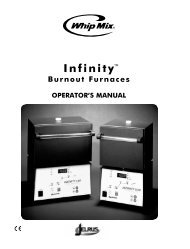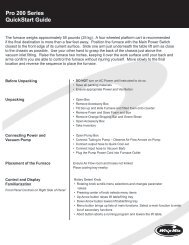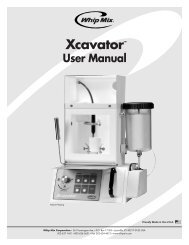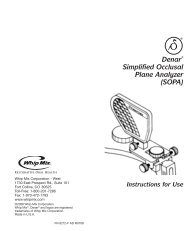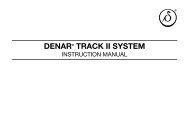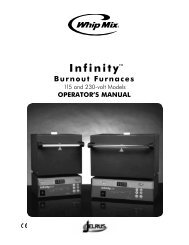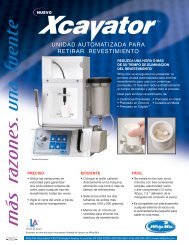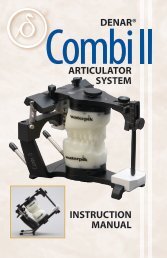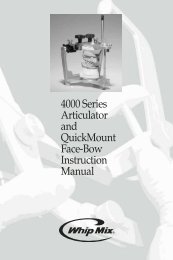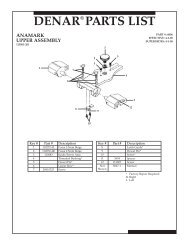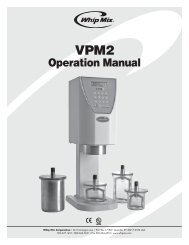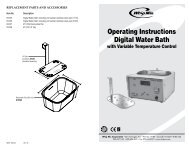Mark II Instruction Manual - Whip Mix
Mark II Instruction Manual - Whip Mix
Mark II Instruction Manual - Whip Mix
Create successful ePaper yourself
Turn your PDF publications into a flip-book with our unique Google optimized e-Paper software.
IX. TREATMENT PROCEDURES<br />
The rationale for utilizing the diagnostic<br />
data obtained from protrusive and lateral<br />
checkbite records is as follows.<br />
When the protrusive inclination of the<br />
superior fossa wall is adjusted to the<br />
lateral checkbite record, a characteristic<br />
of the orbiting condylar path is diagnosed.<br />
This characteristic is associated<br />
with the balancing inclines of posterior<br />
teeth on the orbiting side – the mandibular<br />
buccal cusps’ lingual inclines’ mesial<br />
aspects and the maxillary lingual cusps’<br />
buccal inclines distal aspects.<br />
When the protrusive inclination of the<br />
superior fossa wall is adjusted to the<br />
protrusive checkbite record, the inclination<br />
of the patient’s protrusive condylar<br />
path is diagnosed. This inclination of<br />
the superior fossa wall is associated<br />
with the protrusive contacts of posterior<br />
teeth – the mesial aspects of mandibular<br />
cusps and the distal aspects of maxillary<br />
cusps.<br />
The orbiting path inclination of the superior<br />
fossa wall adjusted to lateral<br />
checkbite records is always equal to or<br />
greater than the protrusive path inclination<br />
of the superior fossa wall adjusted<br />
to the protrusive checkbite record.<br />
FIXED RESTORATION AND<br />
REMOVABLE PARTIAL DENTURE<br />
RESTORATIONS<br />
Adjusting the protrusive inclination of<br />
the superior fossa to an angle which<br />
is slightly less than the patient’s protrusive<br />
condylar path (5 to 10 degrees<br />
less) when the restoration is fabricated<br />
will prevent the fabrication of protrusive<br />
contacts, or balancing contacts on the<br />
orbiting side of posterior teeth in the<br />
laboratory. This is due to the fact that<br />
when the restoration is seated in the patient’s<br />
mouth and the patient’s condyle<br />
tracks a steeper protrusive and orbiting<br />
condylar path, the posterior teeth will<br />
separate in both the protrusive excursion<br />
and in the lateral excursion on the<br />
orbiting side.<br />
COMPLETE DENTURES<br />
Method 1. Adjusting the articulator to<br />
the patient’s protrusive condylar<br />
path inclinations for both the protrusive<br />
and lateral excursive movements<br />
allows the fabrication of protrusive<br />
balance in the laboratory, When the<br />
restoration is seated in the patient’s<br />
mouth and the patient executes a<br />
lateral mandibular movement with<br />
the teeth in contact, the patient will<br />
feel the primary occluding pressures<br />
on the working side. If the patient’s<br />
orbiting path is slightly steeper than<br />
the articulator setting when the restoration<br />
was fabricated, the patient<br />
would perceive minimal occluding<br />
pressures on the balancing side.<br />
However orbiting side occlusal contact<br />
would prevent loss of peripheral<br />
seal.<br />
Method 2. Adjusting the inclinations<br />
of the superior fossa wall to the patient’s<br />
orbiting path inclinations allow<br />
the fabrication of bilateral balanced<br />
occlusion in lateral excursive movements<br />
in the laboratory. Subsequent<br />
adjustment of the articulator to the<br />
patient’s protrusive condylar path<br />
inclinations permit adjustment of the<br />
occlusion to protrusive balance. This<br />
method permits development of full<br />
arch balanced occlusion. (Note: Obtaining<br />
accurate eccentric checkbite<br />
records on extensive tissue borne<br />
restorations, although theoretically<br />
attainable, is a difficult accomplishment).<br />
35



